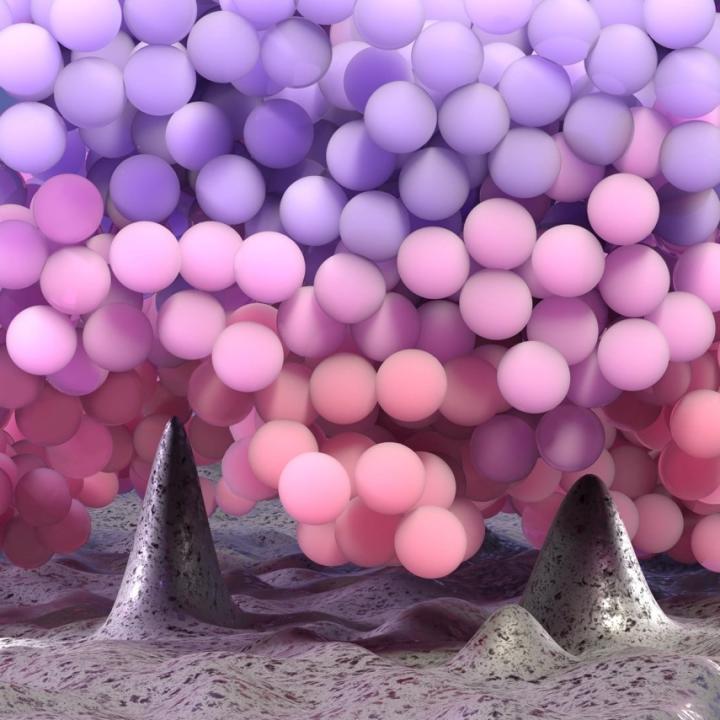Molecules move faster on a rough terrain

3D rendering of polymer chains near the asperities of a rough substrate. Faster molecules were pictured by warmer colors. Credit: © ULB Usage Restrictions: Editorial use only
At the size of smaller objects (1/100 – 1/1000 meter), Italians use pasta shapes with a rough surface, e.g. rigatoni, to make better adhesive surfaces for the tomato sauce and cheese. Till now, however, no experiment was able to test if the behavior of molecules really follows the same trend observed at human scale.
Now writing in Physical Review Letters, Cristian Rodriguez-Tinoco and a team of Université libre de Bruxelles' (ULB) Faculty of Sciences lead by Simone Napolitano shows that large molecules actually move faster in the proximity of rougher surfaces at the nanometric scale.
Their experiments clearly demonstrate that the common belief that surface irregularities allow molecules to better stick on a surface is actually wrong. When the size of the surface roughness, that is the average distance between the tiny hills and valleys present on the surface of a material, is reduced to few nanometers (1 nm = one billionth of a meter), molecules of P4ClS, a type of polymer, start to move faster.
Detecting molecular motion is not easy: molecules move fast (even up to 1 million and more steps per second) and their displacements are too small to be observed by microscopes.
Performing such experiments on a rough surface is even more complicated, because of its uneven character and by the difficulties on adjusting the size and distribution of the surface irregularities. The ULB team has been able to form rough surface of aluminum, by evaporating the metal in a controlled way.
To measure how fast molecules move, the researchers have applied weak electric fields and recorded how quickly the molecules responds to the stimulus.
Surprisingly, the team has noticed that molecules present near a rough substrate behave as if they were surrounded by less neighbors, which explains why they speed up instead of slowing down. This trend is in neat disagreement with the predictions of computer simulations, which proposed that molecules move slower near a rough wall.
Differently than what considered in simulations, polymer molecules do not enjoy sitting near rough substrate. Because of the way in which these molecules like to arrange themselves in the space, they prefer to move away from the asperities. The few molecules present near the asperities form less contact with the wall, can enjoy more free volume and, consequently, they move faster.
By sharing their results with a group of theoreticians of Dartmouth College (USA) led by Jane Lipson, the ULB team has been able to find a strong link between the way hills and valleys are organized on a rough surface and how molecules move.
The theoreticians have shown that a very small change in the free volume around a molecule induces a tremendous boost in mobility, and the prediction of their calculations are in perfect agreement with the experiments.
This paper shows that the current way we think at interfaces is not valid. This new molecular trend observed has thus huge impact at the level of fundamental science. The work of the ULB team could be exploited on a large number of applications.
Since almost a decade, several research groups have shown that properties of many thin coatings – such as flow, the ability to retain or be repel water, the velocity of formation of crystals – depend on the number of contacts between the film and its supporting substrate.
Till now, to modify this number it was necessary to change the type of molecules at the interface, often involving complex chemical reactions. The findings show that it is possible to tailor the performance of nanomaterials by simply changing the roughness of the surface. This method, hence, allows controlling the polymer layer without touching it, as by using a remote control!
###
This work was supported by the FNRS, the Federation Wallonie Bruxelles and the National Science Foundation.
Media Contact
More Information:
http://dx.doi.org/10.1103/PhysRevLett.124.027802All latest news from the category: Physics and Astronomy
This area deals with the fundamental laws and building blocks of nature and how they interact, the properties and the behavior of matter, and research into space and time and their structures.
innovations-report provides in-depth reports and articles on subjects such as astrophysics, laser technologies, nuclear, quantum, particle and solid-state physics, nanotechnologies, planetary research and findings (Mars, Venus) and developments related to the Hubble Telescope.
Newest articles

NASA: Mystery of life’s handedness deepens
The mystery of why life uses molecules with specific orientations has deepened with a NASA-funded discovery that RNA — a key molecule thought to have potentially held the instructions for…

What are the effects of historic lithium mining on water quality?
Study reveals low levels of common contaminants but high levels of other elements in waters associated with an abandoned lithium mine. Lithium ore and mining waste from a historic lithium…

Quantum-inspired design boosts efficiency of heat-to-electricity conversion
Rice engineers take unconventional route to improving thermophotovoltaic systems. Researchers at Rice University have found a new way to improve a key element of thermophotovoltaic (TPV) systems, which convert heat…



